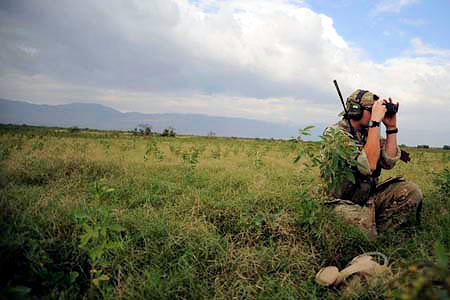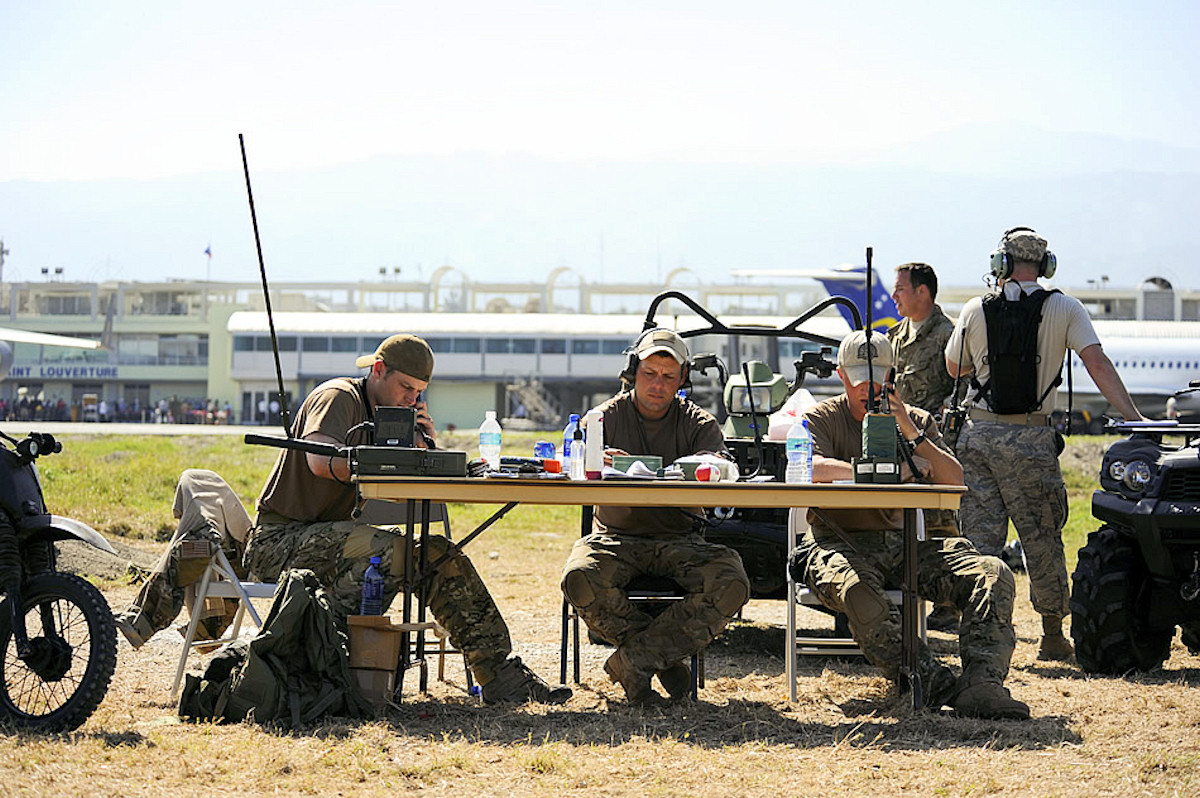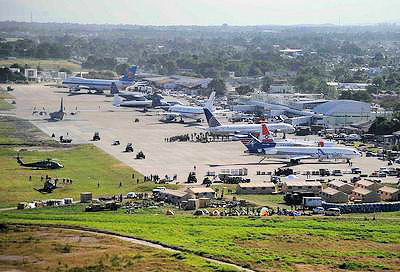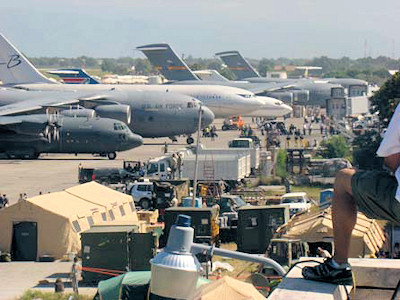

 |
"Herculean
work" Those
are the words Army Maj. Gen. Daniel Allyn, the second in command of the
US military's Haiti relief effort—now called Joint Task Force
Unified Response—used to describe efforts to open and operate
the
international airport in the earthquake-ravaged country. Air Force
Special Operations Command Combat Controllers, among the first US
forces to arrive, had the airport operating within 30 minutes and days
later were coordinating the first airdrop of supplies—15,000 meals and more
than 15,000 liters of water—by a USAF C-17. In talking with
reporters Jan. 19 (transcript), Allyn said, "Air Force units
and supporting units have been doing herculean work, extraordinary
work, at Port-au-Prince." The airdrop capability "has been part of our
arsenal from the outset," said Allyn in response to a question, but it
required coordination on the ground to secure the drop zone and ensure
proper distribution of supplies.
|
| Discovery Channel Daily Planet-Canada taped an interview of Lt. Col Brett Nelson, 23 STS/CC................ Click Here for Video |
|
|
|
| Fox News Report; Combat Controllers take charge and relieve chaos | |
Combat Controllers crucial to Haiti earthquake relief, 01/25/10
Thanks to a specialized group of Airmen used to working in
austere locations, airlift operations in Haiti were possible in the
initial days after an earthquake destroyed much of the capital, and
since then these Airmen have made the airport one of the busiest in the
world.
Combat Controllers are used to working in locations devoid of
functioning air traffic control. Armed and trained to set up and help
secure new airfield operations, these Airmen have made aerial resupply
missions to Port-au-Prince International Airport possible.
"One of our primary jobs (here) is to take over and set up an airfield
in an austere environment and provide air traffic control for follow-on
aircraft, and it's really just the same (as other missions) except
we're not getting shot at," said Staff Sgt. Joshua Craig, a Combat
Controller from the 23rd Special Tactics Squadron at Hurlburt Field,
Fla. "We came in, we set up an airfield in an austere environment, and
immediately after 20 minutes we started bringing in aircraft and aid to
Haiti."
An now, more than a week after the earthquake, they are preparing to
turn over air traffic control operations but only after they made the
airport the busiest in its history.
"In the initial days there were so many aircraft and (so much)
humanitarian aid coming in, they compared it to the Berlin Airlift with
aircraft every three minutes," Sergeant Craig said. "In first days
(after) we got here there were aircraft coming in every five minutes.
Right now, with another airport opening up and the port opening up,
it's lessened traffic."
Though operations are more streamlined, there are still a number of
difficulties these Airmen must overcome.
"The only problem now is that the language barrier is kind of
difficult," said Sergeant Craig. "We have pilots from all over the
world trying to talk and we're trying to use the same phraseology, air
traffic control phraseology, but sometimes it's hard to understand
pilots from different nations."
Another difficulty is the limited physical space to park aircraft at an
airport that was never designed to handle more than 100 aircraft per
day.
"It's a small airport and we've got so many aircraft coming in it's
kind of hard to find the coordination between (radar approach control),
which are the guys brining them in, out, and holding, to the amount of
space we have available here at the airport. We're trying to put
(aircraft) in the grass, utilizing as much space as we can in the
airport."
Though it's difficult to find space for known aircraft, Sergeant Craig
and the other Combat Controllers also must find places for aircraft
they've never seen before.
"We get birds in with types that we've never heard of so we have to ask
them, 'what's your wingspan, what kind of a bird are you, how fast are
you,'" he said.
With a portable tower being erected, the Combat Controllers will depart
when the tower is up and running. However, Sergeant Craig and his
fellow Combat Controllers will bring (the replacement controllers) up
to speed before departing.
"Once that tower is up we're definitely going to do a handover with the
air traffic controllers," he said. "We're probably going to take no
less than 96 hours. The first day we're going to do it and let them
watch. The second day they're going to integrate a little bit. The
third day we're going to let them do and we're going to watch. The
forth day we're going to let them do it all and we're going to give
them a hand if they need it."
Though Sergeant Craig and his fellow Airmen have proven crucial to
Operation Unified Response, with the more permanent and capable tower
nearly ready it's time for them to abandon their card table in the
grass and go to where they are needed next.
"Our job is austere airfields so once they set up towers it's time for
us to go," he said.

Combat Controllers talk to aircraft circling the Toussaint L'Ouverture
International Airport in Port-au-Prince, Haiti, Jan.
23, 2010. The Airmen are from the 23rd Special Tactics Squadron at
Hurlburt Field, Fla. In the initial days of Operation Unified Response
air operations were similar to the Berlin Airlift with aircraft landing
every five minutes. Now, aircraft from all over the world are still
flying in and out to drop off humanitarian aid and transport people out
of the Haiti.
Haiti: Boots on the
Ground Perspective............ sent
by Wayne Norrad
Colonel Buck Elton
Buck Elton is
the Commander of
Joint Special Operations Air Component-Haiti. Small Wars Journal
inadvertently received an e-mail update from Buck to his family and
friends. SWJ asked if we could publish his insightful account and he
most graciously agreed. What follows addresses many issues now
appearing in the press – here is a boots on the ground
perspective.
 |
On Jan 13th I
deployed with a few hours notice to Port au Prince to
command a team of Air Commandos from Air Force Special Operations
Command at Hurlburt Field on a Humanitarian Assistance/Disaster Relief
mission in Haiti. We launched from Hurlburt within a few hours of
notification without knowing what to expect at the airfield due to very
limited communications with anyone in Haiti. We landed at 7 pm EST and
had the Port au Prince airfield under our tactical air traffic control
(ATC) 28 minutes later. I am the commander of the Joint Special Operations Air Component-Haiti. I lead a force of 220 airmen (down to 164 now) executing ATC, airfield security, rescue, critical care evacuation, special operations surgical teams, aerial port duties, humanitarian airdrop surveys, planning, and DZ control, rotary wing ops command and control, communications specialists and logistics professionals. Most of us operated non-stop without sleep for the first 40 hours. We had no showers for the first 9 days; I slept 9 hours in the first 4 days. We are still eating only MREs, mosquitoes everywhere and absolute carnage outside of the wire. The stench of rotting bodies in the rubble makes driving in some areas difficult. Buildings are destroyed everywhere in the city and parts of the country. There are 59 confirmed and 37 reported (unconfirmed) US fatalities and up to 150,000 Haitian citizens reported dead or missing. Over $780M has been donated and another $1.2B has been pledged by the international community. 690K refugees |
| I was interviewed by Katie Couric, Brian Williams, Al Rocher, BBC, Reuters, French TV 24 and did two telecon interviews with 250 reporters. I coordinated directly with Senator John Edwards to arrange the evacuation of 28 critically injured Haitian citizens to Florida. John Travolta showed up in his Boeing 707 last night, but I went to bed and had a few airmen go get a picture with him. I briefed SECSTATE Hillary Clinton, former POTUS Bill Clinton, and more 3-4 star Generals than I can count. I had a problem with where we were taking US citizens and asked a National Security Council staffer to help me out. He emailed Janet Napolitano on his BlackBerry. She authorized me to move any US Citizen to any US location, overriding guidance I got from the Joint Staff and the US Air Force. I had to threaten an international flight crew that I would tow their 737 into the grass if they did not immediately depart the airfield (they had been on the ground for over 7 hours while aircraft were diverting due to no available parking) I told 50 reporters that if they didn't move their cars away from where an aeromedical evacuation flight was supposed to park I would bulldoze all the cars into the grass and off the ramp. I ordered the evacuation of 54 orphans on a C-17 against the specific direction of the American Consulate General here at the Embassy, but with the full support of the DHS, INS, NSC and ICE. I met with the Haitian Secretary of State for Agriculture and convinced him to allow airdrop resupply of humanitarian aid. |  |
|
Combat Controllers
relinquish their duties to the National Guard
|